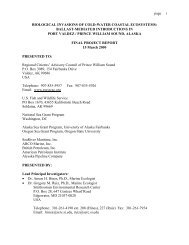Harmful Non-Indigenous Species in the United States - Aquatic ...
Harmful Non-Indigenous Species in the United States - Aquatic ...
Harmful Non-Indigenous Species in the United States - Aquatic ...
Create successful ePaper yourself
Turn your PDF publications into a flip-book with our unique Google optimized e-Paper software.
66 <strong>Harmful</strong> <strong>Non</strong>-<strong>Indigenous</strong> <strong>Species</strong> <strong>in</strong> <strong>the</strong> <strong>United</strong> <strong>States</strong>Box 2-C-Economic Losses Caused by <strong>Non</strong>-<strong>Indigenous</strong> WeedsThe Weed Science Society of America (WSSA) recently published <strong>the</strong> report Crop Losses Due toWeeds-1992, cover<strong>in</strong>g all <strong>States</strong> but Alaska. The report relies on crop loss estimates for 46 major crops (<strong>in</strong>clud<strong>in</strong>gfield crops, fruits, nuts, and vegetables) obta<strong>in</strong>ed through survey responses by cooperat<strong>in</strong>g weed seientists. Thescientists estimated <strong>the</strong> cumulative value of average losses to be $4.1 billion annually, undercurrent appropriateherbicide control strategies. They also estimated that if no herbicides were available <strong>the</strong> crop losses would total$19.6 billion.The WSSA figures have several limitations for OTA’s purposes: <strong>the</strong>y only characterize a 3-year period(1969-1991); <strong>the</strong>y do not cover weeds of forestry, graz<strong>in</strong>g lands, horticulture, and o<strong>the</strong>r agricultural sectors; and<strong>the</strong>y <strong>in</strong>clude <strong>in</strong>digenous weeds. However, <strong>in</strong>digenous weeds are less important economically than NIS, which areknown to comprise <strong>the</strong> majority of weeds for most crops. For example, 23 of 37 major soybean weeds, or 62percent, are NIS. Experts estimate that 50 percent to 75 percent of major crop weeds overall are NIS. Based on<strong>the</strong>se percentages, <strong>the</strong> portion of <strong>the</strong>$4.1 billion of annual crop losses attributable to non-<strong>in</strong>digenous weeds wouldbe approximately $2 billion to $3 billion. Accord<strong>in</strong>g to <strong>the</strong> Environmental Protection Agency, U.S. farm expenditureson pesticides amount to about $5.1 billion annually, 60 percent of which is for herbicides. Thus, roughly $1.5 billionto $2.3 billion spent annually for herbicides would be attributable to NIS.A ballpark range for total direct non-<strong>in</strong>digenous weed costs is $3.6 billion to $5.4 billion annually. Theenvironmental, human health, regulatory, and o<strong>the</strong>r <strong>in</strong>direct costs of us<strong>in</strong>g herbicides on non-<strong>in</strong>digenous weedshave not been adequately calculated, but rough estimates exceed an additional $1 billion annually.SOURCES: D.C. Bridges (cd.), CmpLosses Due fo YWa&irr <strong>the</strong> UMed$tatas — 1992 (Champaign, IL: VI&M! Sdence Sodety of America,1992); D.T. Patterson, “Research on Exotic Weeds,” <strong>in</strong> Exotic P/ant Pasts and AkWrAndcarr A@xf/ture, C.L. Wilson and C,L. Graham(eds.) (NewYorlG NY: Aoademic Press, 19S!3), pp. SS1-93; D. Pimentel etal., ‘Environmental and Economic Effects of Redudng PesticideUse,” Biosderm, vol. 41, No. 6, June 1991, pp. 402-9; U.S. Environmental Protection Agency, “EFM’s Pestidde Programs,” PublicationNo. 21 T-1OO5, Wash<strong>in</strong>gton, DC, May 1991; T.D. Whitson et al., WeedJ of <strong>the</strong> Wsst(Jac-kson, WY: Pioneer of Jackson Hofe, 1991).losses from <strong>in</strong>sect pests compiled for OTA by <strong>the</strong>Animal and Plant Health Inspection Service ofUSDA <strong>in</strong>clude: $500 million (<strong>in</strong> 1990) for <strong>the</strong>alfalfa weevil (Hypera postica); $172.8 million(<strong>in</strong> 1988) for <strong>the</strong> Russian wheat aphid; and $16.6million (annual average for 1960-1988) for <strong>the</strong>p<strong>in</strong>k bollworm (Pect<strong>in</strong>ophora gossypiella) <strong>in</strong>California (17).The honey bee <strong>in</strong>dustry currently faces twonew pests, <strong>the</strong> tracheal mite (Acarapis woodi) and<strong>the</strong> varroa mite (Varroa jacobsoni), which parasitizeand kill honey bees. The National Associationof State Departments of Agriculture estimatespotential annual losses of $160 million—due to lost honey production, lost poll<strong>in</strong>ation fees,and costs of replac<strong>in</strong>g bees—should each pesthave nationwide effects similar to those reported<strong>in</strong> Michigan (1990) and Wash<strong>in</strong>gton (1989) (59).FORESTRYIn <strong>the</strong> early 1900s, <strong>the</strong> chestnut blight, brought<strong>in</strong> on diseased horticultural stock from Ch<strong>in</strong>a, allbut elim<strong>in</strong>ated <strong>the</strong> American chestnut (Castaneadentata), kill<strong>in</strong>g as many as a billion trees.American chestnut had been <strong>the</strong> most economicallyimportant hardwood species <strong>in</strong> easternforests (91). It was widely used <strong>in</strong> urban plant<strong>in</strong>gsand had been a significant food source for wildanimals (72). Dutch elm disease (Ceratocystisulmi) also devastated vast numbers of shade treesfollow<strong>in</strong>g its U.S. discovery <strong>in</strong> 1930-an aes<strong>the</strong>ticloss for many U.S. cities as well as anexpense to replace <strong>the</strong> 40 million elms estimatedto have died (91).Several o<strong>the</strong>r NIS currently threaten U.S.forests, <strong>in</strong>clud<strong>in</strong>g <strong>in</strong>sects like <strong>the</strong> balsam woolyadelgid (Adelges piceae) and pathogens such aswhite p<strong>in</strong>e blister rust (Cronartium ribicola). Pear














